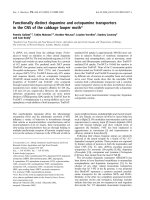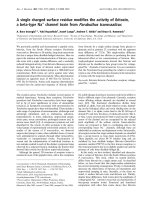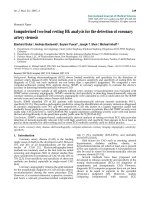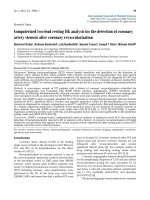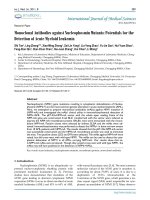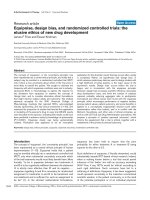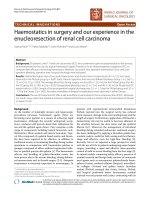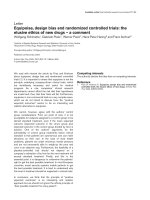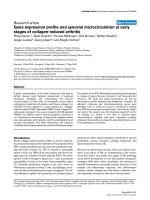Báo cáo y học: "Assessing food appeal and desire to eat: the effects of portion size & energy density" pptx
Bạn đang xem bản rút gọn của tài liệu. Xem và tải ngay bản đầy đủ của tài liệu tại đây (274.77 KB, 9 trang )
RESEARCH Open Access
Assessing food appeal and desire to eat: the
effects of portion size & energy density
Kyle S Burger
1,2
, Marc A Cornier
3
, Jan Ingebrigtsen
4
and Susan L Johnson
1*
Abstract
Background: Visual presentation of food provides considerable information such as its potential for palatability
and availability, both of which can impact eating behavior.
Methods: We investigated the subjective ratings for food appeal and desire to eat when exposed to food pictures
in a fed sample (n = 129) using the computer paradigm ImageRate. Food appeal and desire to eat were analyzed
for the effects of food group, portion size and energy density of the foods presented as well as by participant
characteristics.
Results: Food appeal ratings were significantly higher than those for desire to eat (57.9 ± 11.6 v. 44.7 ± 18.0; p <
0.05). Body mass index was positively correlated to desire to eat (r = 0.20; p < 0.05), but not food appeal. Food
category analyses revealed that fruit was the highest rated food category for both appeal and desire, followed by
discretionary foods. Additionally, overweight individuals reported higher ratings of desire to eat large portions of
food compared to smaller portions (p < 0.001), although these effect s were relatively small. Energy density of the
foods was inversely correlated with ratings for both appeal and desire (r’s = - 0.27; p’s < 0.01).
Conclusions: Results support the hypothesis that individuals differentiate between food appeal and desire to eat
foods when assessing these ratings using the same type of metric. Additionally, relations among food appeal and
desire to eat ratings and body mass show overweight individuals could be more responsive to visual foods cues in
a manner that contributes to obesity.
Keywords: liking, wanting, food appeal, desire to eat, intake, hedonic, obesity, portion size
Background
Food intake is influenced by a number of factors such as
visual food cues in the eating environme nt, the hedonic
value of food and an individual ’s energy state [1-3]. In
today’ s environment individuals are presented with
visual food cues on a continual basis. Images of foods
appear in print media, on screen and are visually pre-
sented when others are eating. By simply seeing food
one is aware of its avail abilit y and pot ential palatability,
both of which can act as incentive to initiate food intake
[4]. Studies have reported that altering the visual aspects
of food, such as portion size and visibility, can increase
food intake [5-7], yet little is known about the mechan-
isms by which this occurs. To understand the possible
physiologic basis of the effect of visual presentation of
food, research has assessed brain activation in response
to food pictures. These studies have reported that brain
activation in reward and attention related areas is
increased when individuals are shown pictures of energy
dense, highly palatable foods [8] and that activation
resulting from high calorie foods is positively associated
with body mass index [8-10]. However little is known
about individuals’ prefe rences for these types of food
items and their interactions with food characteristics
known to influence food selection (e.g., food categories,
portion size, and energy density) individual characteris-
tics such as body mass and levels of dietary restraint
and disinhibition.
Food Liking & Wanting
A positive hedonic value of food, or food reward, is a
powerful determinant of eating behavior [11]. Neural
* Correspondence:
1
Department of Pediatrics, Section of Nutrition, University of Colorado
Denver, Aurora, CO, USA
Full list of author information is available at the end of the article
Burger et al. International Journal of Behavioral Nutrition and Physical Activity 2011, 8:101
/>© 2011 Burger et al; licensee BioMed C entral Ltd. This is an Open Access article distributed under the terms of the Creative Commons
Attribution License ( which p ermits unrestricted use, distribution, and reproduction in
any medium, provided the original work is properly cited.
responses to positive hedonic food cues occur on two
levels, ‘liking’ and ‘wanting’ and have independent neural
pathways [12]. While liking is commonly conceptualized
as the positive hedonic value of food and frequently
measured via visual analog scale, wanting referred to the
incentive salience and/or motivation to consume that
food item [12,13] and ha s been measured in a variety of
ways [14-18]. Epstein and colleagues interpreted Ber-
ridge’s “motivation to consume” as the amount of work
(e.g., pushing a button) an individual would perform to
receive food [14]. Wanting has also been measured by
asking a participant to choose a pref erred food (between
two food items) and measuring reaction time [17]. Fin-
layson and colleagues selected this ‘ forced choice’
method citing that individuals may not be able to differ-
entiate between subjective liking and wan ting and that
wanting could occur unconsciously [17], although this
has not been empirically tested. Whereas in a repeated
measure experiment, Liem and colleagues (2009) used a
Lykert type scale after children tasted foods [18].
Further, there are few empirical data available that test
the ability to reliably assess differences in subjective lik-
ing and wanting in a sim ilar metric in adults (for exam-
ple, v isual analog sc ales). However, based on the
differences in these methodologies and lack of the ability
to test against a gold-standard, it is unclear if they are
measuring the same specific construct. Additio nally few
data are available regarding the relations between liking
and wanting and hunger and satiation. Epstein and col-
leagues have shown that the depravation of food can
selectively influence the willingness to work for food
[14]. It has been hypothesized that the physiological
state of hunger can influencedesiretoeat[19],butit
also has been reported that subjective food liking oper-
ates independently of perceived hunger [20].
The Eating Environment & Portion Size
The effect of large por tions on food intake is well
researched. The influence and change in portion sizes
over the past three decades have been suggested to sig-
nificantly contribute to the obesity epidemic [21]. Po r-
tion sizes have increased in a near parallel rate to the
rise in ob esity [22] and increases in portion sizes have
been shown to markedly increase food and energy
intake in both children [23,24] and adults [5,25,26],
although only few studies have reported a direct rela-
tionship between portions of food and BMI [7,27,28].
Currently there is a gap in the literature regarding the
mechanisms by which portion size impacts intake. We
previously theorized that the initial amount of food pre-
sented could impact food intake based on reports that
removing the visual c ue of food after seeing the meal
(via blindfolding) did not attenuate the portion s ize
effect [7]. To date, few studies have directly assessed
food appeal and desire to eat of a variety of foods varied
by portion size without the confound effects of satiety.
Study Aims and Hypotheses
This study aimed to assess the reliability of a computer
paradigm and image set that could be easily dissemi-
nated to investigate individuals’ characteristics and simi-
larities and differences between food appeal and desire
to eat. In addition, we a imed to examine the relation-
ships among food appeal ratings and ratings of desire to
eat, food categories, portion size, energy density, and
participant characteri stics. Our primary hypotheses
included: 1) food appeal and desire to eat would be
positively correlated, but individuals wo uld differentiate
between these t wo constructs, specifically desire to eat
would be rated lower by nature of the controlled full
energy state of the participants (see methods); 2) when
separating food images by category, discretionary foods
(desserts, ener gy dense foods) would be rated highest in
both food appeal and desire to eat; 3) BMI, hunger and
dietary disinhibitio n would be positively associated with
desire and appeal ratings, whereas fullness and dietary
restraint would have inverse relations with desire a nd
appeal ratings; 4) individuals would rate large portions
of food higher for appeal and desire; and 5) energy den-
sity of food would be positively associated with food
appeal and desire to eat ratings.
Methods
Image Set Development
Over 600 images of food were considered for inclusion
into the set including those: 1) taken by lab personnel;
2) obtained via the internet; 3) from the International
Affective Picture System [29]; 4) and used in previous
fMRI research [30,31]. Permission was obtained to use
images downloaded from the internet and from previous
research. All images were matched for brightness and
contrast using Microsoft Office Picture Manager
®
(Microsoft, Seattle WA, 2007), were sized to be at least
800 × 600 pixels and were converted to a JPEG file type.
After the images were standardized, images were
excluded if: the image quality (clarity, brightness, con-
trast) was poor or the food could not be easily identi-
fied; if there was an overrepresentation of a kind of food
item; or if the food was presented in a manner not typi-
cal for consumption (e.g., a whole, uncut pineapple).
Liquids were excluded from the image set due to the
difficulty in identifying the liquid. Images were selected
to represent a variety of ethnic foods and food cate-
gories as well as different portion sizes.
Food images were assigned to categories similar to
food groups presented in the Health and Human Ser-
vices 2005 Dietary Guidelines for Americans [32]. When
a mixed plate of food was shown, the category assigned
Burger et al. International Journal of Behavioral Nutrition and Physical Activity 2011, 8:101
/>Page 2 of 9
represented the predominant food item in the image, as
determined by five members of the research staff. If
there was no predominant food, the image was placed
into a “ mixed dish” category. Examples of foods repre-
sented in each category and the number of images in
each category can be seen in Table 1.
A total 165 food images were presented to each parti-
cipant in a random order. This included 104 unique
food images, 46 images of foods which varied by portion
size (23 food pairs) and 15 repeated images for reliability
analyses.
The 46 portion size images were all photographed by
research staff. Twenty-thre e foods were presented in a
small portion (based on one serving per manufacturer
nutritional facts label or USDA guidelines) and a large
portion (double the small portion). Each of the portion
size images was photographed with identical presenta-
tion on the same plate in the same lighting. The angle
and distance from which these images were taken were
based on ho w an average height male (5’ 10”) would see
a food if seated at a table. These techniques were used
to ensure the scale of the foods included in the portion
size images consistent and apparent.
For reliability analyses, five sets of 15 images were
randomly selected from the original 150. One of the five
sets was imbedded randomly into the original set of 150
images for each participant. Thus, each participant rated
a total of 165 images in their session. Across the entire
sample of participants, reliability data was collected on a
total of 75 different images (5 sets of 15 images). Relia-
bility was not assessed on all 150 images to minimize
participant burden.
ImageRate Computer Paradigm
The computer program ImageRate was written in
Visual Basic for Applications (Microsoft, Seattle WA,
2007) and Microsoft O ffice Access
®
(Microsoft, Seattle
WA, 2007) was used as user interface and data storage.
The images were presented to the participant one at a
time in a random order on a 17 inch (176 cm) moni-
tor. Ratings were assessed f or each image by visual
analog scales (VAS; 0-100) measuring food appeal and
desire to eat the food presented in the image. The
question measuring food appeal was phrased ‘ How
appealingisthisfood?’ anchored by ‘ Not appealing at
all’ to ‘Extremely appealing.’ Appeal was defined as the
amount the person liked the pre sented food item. The
question to measuring desire to eat was phrased, ‘How
much do you desire to eat this food?’ anchored by ‘I
have no desire to eat this food’ to ‘ Ihaveastrong
desire to eat this food.’ Desire to eat was specifically
defined as the drive to consume some of the presented
food at that point in time. The VAS were presented
under the image of the food one at a time and partici-
pants progressed through the images and questions at
their own pace.
Measures & Procedures
A total of 130 individuals (M = 56, F = 74) completed
the study. One woman was excluded from analysis due
to an outlying BMI (62.4). This participant’ sBMIwas
four SD above the mean and a Cook’sDistancegreater
than 1 revealed that her BMI was an overly influential
data point. All subsequent analyses are presented on the
remaining 129 participants. Seventy-four participants (M
= 27, F = 47) were classified as lean (BMI 21.6 ± 1.9)
and 55 participants (M = 29, F = 26) were classified as
overweight (BMI 31.7 ± 6.8). Demographic information
and participant characteristics are presented i n Table 2.
Participants were recruited via flyer, email distribution
lists and website message boards regarding a study
investigating ‘opinions about food’ in the Denver Metro
and Northern Colorado areas. No further information
regarding the purpose of the study was given. Indivi-
duals were excluded if they had a visual disability that
would affect the ability to differentiate colors or impair
seeing in the dark or any developmental disability that
could impact data collection.
Table 1 Descriptive information of the food images and categories selected for the ImageRate program
Number of Images
Included
Examples of Foods in Each Category
Fruit 18 Strawberries, ready to eat oranges and mixed fruit platters
Discretionary
foods
21 Brownies, ice cream, cakes and high calorie savory foods such as French fries, and potato chips.
Grains 16 Breads, pastas, bagels and cereals
Dairy 5 Different types of cheese and butter
Vegetables 15 Broccoli, baked potatoes, peas and mixed vegetable dishes (e.g., salad or salsa)
Mixed dishes 28 A plate with eggs and hash browns, a basket of fish and chips and pizza with meat and vegetable
toppings
Protein 24 A steak, chicken, seafood, and eggs
Total 127
Burger et al. International Journal of Behavioral Nutrition and Physical Activity 2011, 8:101
/>Page 3 of 9
Each participant attended one session conducted
either at the University of Colorado -Denver or Color-
ado State University. Prior to the session participants
were asked to adhere to their normal eating habits,
upon arrival, once informed consent was reviewed and
obtained, participants were first asked to drink ≥ 80% of
a Boost
®
nutritional drink (Nestlé HealthCare Nutrition,
Fremont, MI 2008) to control for individuals’ hunger/
fullness levels across the sample. The nutritional drink
contained 240 kcal, 10 grams of pro tein and 4 grams of
fat. A gap of 15 minutes was placed between consump-
tion of the nutritional drink and ratings to allow for t he
satiating effect of the supplement to occur. Participants
were then asked to fill out VAS for hunger and fullness
(0-100; ranging from not hungry/full at all to extremely
hungry/full) prior to the ImageRate procedure.
The participant was given instructions on how to use
the ImageRate program and given the opportunity to
practice with the assistance of the researcher to ensure
complete understanding of the procedures. All ratings
were completed on the same 17 inch (176 cm) compu-
ter monitor in a quiet, dimly lit, private room. Once the
image rating was finished, the participant then com-
pleted the Three Factor Eating Questionnaire (TFEQ)
[33]. The TFEQ assesses dietary behaviors designed to
produce weight loss or maintenance, monitoring of
body shape, and importance of thinness (sample item: I
count calories as a cons cious means of controlling my
weight). This scale has shown internal consistency (a’s
ranged from .85 to .93) and temporal reliability; 1-
month test-retest r = .98 [33,34]. Constructs of interest
for this investigation were dietary restraint (range 0-21)
and dietary disinhibition (rang e 0-16). At the en d of the
session, the participant’ s height and weight were mea-
sured with a standardized scale and stadiometer. All
procedures and measures were approved by the Color-
ado Multiple Institutional Review Board.
Statistical Analyses
Statistical analyses were performed using SAS Version
9.1 (SAS Institute Inc, Cary, NC 2003). All tests were
two-sided, with the significance level set at p < 0.05.
Data are presented as mean ± standard deviation (SD)
unless otherwise specified. Descriptive statistics were
performed on all data including means, SD, standard
error of the means (SEM) and weight status. Weight sta-
tus was determined by calculating body mass index
(BMI; kg/m
2
) and then BMIs were dichotomized into
lean (BMI < 25) and overweight (BMI ≥ 25) groups.
Independent measures t-tests were used to compare
participant characteristics by weight status and sex.
Appeal and desire were analyzed using repeated mea-
sures t-tests to study differences in ratings a mong food
categories, and food appeal and desire to eat for each
food category. Pearson correlations were used to analyze
the relationships among appeal and desire by food cate-
gory and participant characteristics. Participant charac-
teristics of interest included: BMI, hunger, fullness a nd
dietary restraint and disinhibition. To study the effect of
portion size on appeal and desire ratings, difference
score s were calculated between ratings for the large and
small portions. Previous reports suggest differential
responses to portion size by sex and weight status [35].
To account for this, weight status, sex, level of fullness
and interactions where included in the repeated mea-
sures analyses of vari ance model when testing the effect
of portion size on ratings. In the case of a significant
interaction, least squared means were compared using a
Tukey-Kramer adjustment for multiple comparisons (p
< 0.05). The USDA Food Database was used for the
dietary analyses of the energy (kcal/food (g)). Pearson
correlational analyses were used to study the relation-
ship between appeal and desire ratings and energy den-
sity. Pearson correlations and Cronbach’ s a were
calculated to assess test/retest reliability utilizing the
repeated images that were imbedded into the image set.
Results
Food Appeal & Desire to Eat Ratings
The overall mean ratings for appeal and desire are pre-
sented in Table 3. Food appeal was significantly higher
than desire to eat (57.9 ± 11.6 v. 44.7 ± 18.0; t = 3.14; p
< 0.05; Table 3), yet appeal and desire were positively
correlated (r =0.57,p < 0.001). When examining at the
food categories, fruit had a mean appeal rating of 71.8,
which was significantly higher than all other food cate-
gories (ratings ranged from 49.3 - 61.7). A similar pat-
tern was observed in desire (Table 3).
BMI was positively associated with ratings for desire
to eat, but not food appeal (Table 4). When examining
the relationship between weight status and ratings by
food category, BMI was the only significant correlate of
Table 2 Sample description and characteristics
Men Women Total
n 56 73 129
Age (y) 34.5 (11.2) 33.3 (11.3) 33.8 (11.5)
BMI 26.0 (5.5) 25.7 (7.8) 25.9 (6.8)
Education (y) 16.1 (1.2)
a
15.5 (1.7)
b
15.7 (1.5)
Dietary Restraint
#
8.1 (4.5) 9.0 (4.5) 8.6 (4.5)
Dietary Disinhibition
#
5.3 (3.3) 6.4 (3.7) 5.9 (3.6)
Hunger 35.0 (23.3)
a
25.2 (21.3)
b
29.5 (22.6
Fullness 45.6 (23.9)
a
59.0 (22.1)
b
53.2 (23.7)
Values are presented in mean (SD)
a, b
Different superscripts indicate significant differences between men and
women p < 0.05
#
Measured via the Three Factor Eating Questionnaire [33]. Scale ranges:
restraint (0 - low reported restraint, 21 - high dietary restraint); disinhibition (0
- low reported disinhibition, 16 -high reported disinhibition)
Burger et al. International Journal of Behavioral Nutrition and Physical Activity 2011, 8:101
/>Page 4 of 9
appeal ratings for discretionary foods (Table 4). The
relationship between BMI and desire to eat discretionary
foods was driven by overweight individuals in that BMI
was correlated with desire t o eat discretionary foods in
overweight (r =0.38,p < 0.01), but not lean individuals.
Desire to eat discretionary foods, grains, vegetables, and
protein all had similar correlation with BMI, followed
closely by trending relationship with mixed dishes and
dairy foods. For ratings of desire to eat of the fruit cate-
gory was the only category not significantly correlated
(or trending towards significance) to BMI.
Hunger and fullness were associated with desire in the
directions one would anticipate: i.e., as hunger increased,
desire increased and as fullness increased, desire
decreased. However, neither hunger nor fullness were
associated with food appeal (Table 4). When analyzed
by weight status, the relationship between hunger and
food appeal was significant for overweight (r =0.27,p =
0.05), but not lean individuals (p =0.37).Analysesof
appeal ratings by food categories revealed that only
mixed dishes and protein were associated with hunger
and fullness, whereas most food categories (except fruits
and discretionary foods) were related to desire (Table 4).
Reported dietary restraint was negatively correlated to
desire to eat all foods, but not significantly related to food
appeal, whereas disinhibition was not significantly asso-
ciated with either of the ratings (Table 4). Overweight
individuals reported higher restraint (9.6 ± 4.7 v. 7.9 ± 4.3;
p < 0.05) and disinhibition (6.8 ± 3.9 v. 5.4 ± 3.4; p < 0.05)
relative to lean individuals, although these differences are
clinically marginal. The relationship between desire to eat
and dietary restraint was significant in lean (r = -0.24, p <
0.05), but not overweight individuals. When analyzed by
food category, restraint was negatively associated with
desire grains, vegetables, mixed dishes an d protein, but
was not related to fruits, discretionary foods or dairy, nota-
bly both high fat food categories (Table 4). Similar to the
findings with hunger and fullness, the two highest r ated
categories i.e., discretionary foods and fruits, were not
associated with restraint. Disinhibition was positively cor-
related with desire to eat discretionary foods (Table 4).
Portion Size, Energy Density & Reliability
Mean difference scores (large portion rating - small por-
tion rating) revealed that individuals rated large portions
Table 3 Ratings of images by food category
Food Appeal (± SD) Desire to Eat (± SD)
Fruit 71.8 (12.7)*
a
59.7 (19.9)*
b
Discretionary foods 61.7 (14.1)
a
45.9 (21.6)
b
Grains 58.1 (13.9)
a
44.3 (21.0)
b
Dairy 49.3 (17.8)
a
38.3 (21.8)
b
Vegetables 56.2 (13.2)
a
41.5 (19.3)
b
Mixed dishes 55.2 (14.9)
a
42.6 (21.6)
b
Protein 53.4 (17.8)
a
40.9 (23.6)
b
Total 57.9 (11.6)
a
44.7 (18.0)
b
*indicates fruit is rate d significantly higher than the other food categories (p <
0.05)
a, b
different superscripts indicate significant differences between appeal and
desire within a food category (p < 0.05)
Table 4 Pearson correlations between appeal and desire ratings by food category and participant characteristics
BMI Hunger Fullness Dietary Restraint Dietary Disinhibition
Food Appeal
All foods .15 .16 10 11 08
Fruits .02 12 .12 .02 12
Discretionary foods .29** 03 01 07 .03
Grains .13 .15 14 10 04
Dairy .01 .12 01 04 12
Vegetables .10 .06 04 07 07
Mixed Dishes .12 .30** 23* 14 01
Protein .13 .29** 20* 16 07
Desire to Eat
All Foods .20* .34** 24** 21* .11
Fruits .04 .06 01 11 .02
Discretionary foods .20* .09 07 15 .19*
Grains .19* .30** 25** 21* .15
Dairy .16
^
.36** 24** 09 .08
Vegetables .18* .31** 22* 19* .07
Mixed Dishes .17
^
.41** 32** 21* .12
Protein .19* .41** 29** 24** .05
**p < 0.01
*p < 0.05
^
p = 0.05
Burger et al. International Journal of Behavioral Nutrition and Physical Activity 2011, 8:101
/>Page 5 of 9
higher than small portions for both appeal, where the
large portion was rated 2.6 ± 4.4 higher than the small
portion (p <0.001),aswellasdesiretoeat,wherethe
large portion was rated 1.6 ± 3.9 higher than the small
(p < 0.001). Analysis of variance main effects of weight
status and portion size were observed for ratings o f
desire to eat: overweight participants’ difference scores
were significantly higher than lean individuals’ scores for
desire to eat (2.3 ± 0.5 v. 0.8 ± 0.5; p < 0.05). In addi-
tion, a significant weight status by sex interaction was
observed, specifically overweight men’s difference scores
were larger compared to lean men’sscores(2.7±0.7v.
-0.3 ± 0.8; p < 0.05).
Pearson correlation analyses among scores for food
appeal, desire, and energy and sugar densities of the
foods were analyzed. Appeal and desire were negatively
correlated with energy density of the foods presente d in
the images (r = -0.27, p <0.01;r = -0.27, p <0.01
respectively).
Measures of reliability for ratings of appeal and desire
were high for both test-retest reliability and internal
consistency: food appeal (r =0.91,Cronbach’s a =0.95;
p < 0.001) and desire to eat (r = 0.91, Cronbach’ s a =
0.95; p < 0.001).
Discussion
Food appeal and desire to eat were correlated, but their
differential relations with individual characteristics and
different overall mean ratings indicate that participants
discriminated between the two constructs despite using
the same type of metric to measure them. The present
results for appeal and desire to eat dovetail previous
reports differentiating liking from wanting [17], and
wanting’s relation to weight status [19,36,37]. The con-
sistency in these findings is encouraging given previous
studies used different methods (i.e., button pushing vs.,
asking desire to eat) and terms (i.e., ‘ liking’ v. ‘food
appeal’ ). This suggests these measures are capturing
aspects of the same construct and confirm the ability
for individuals to reliably differentiate between liking
and wanting. However given the current lack of a gold
standard, the ability to empirically test this notion is
unavailable. Results from the present study suggest that
the distinction between appe al and desire m ight be
moderated by weight status. For example, BMI was posi-
tively related to desire, but not appeal ratings. This sug-
gests that desire to eat a food item could play a larger
role in the dysregulation of weight status relative to the
food’s preference. However, to date, the majority studies
evaluating liking and wanting are cross-sectio nal and
few involve food [17,37-39]. Therefore future studies
should consider prospective designs to demonstrate the
relations between liking and wanting, habitual intake
and weight gain.
We observed that BMI was positively associated with
desire to eat discretionary foods, however ratings for
these foods had no association with hunger or fullness.
This could suggest that overweight individuals’ desire to
eat highly palatable foods is “ overriding” homeostatic
mechanisms that control food intake (i.e., satiation).
These results dovetail previous theories of the develop-
ment of obesity where overweight individual s’ eat for
pleasure [19], consume energy dense foods in response
to hedonic hunger [40], and are highly susceptible to
environmental food cues [41].
The current data demonstrate that as l ean individual s’
restraint increases, their desire to eat a highly palatable
food decreases. Overweig ht individual s’ dietary restraint
did not relate to their desire to eat a food, despite over-
weight individuals reporting slightly higher levels of
dietary restraint. Notably, dietary restraint scores have
been previously reported to be unrelated to measures of
acute [42,43] or habitual intake [44,45] but were posi-
tively related to increases in weight [46,47] and onset of
binge eating and bulimia [48,49]. Fur ther, restraint has
been previously reported to be positively associated with
activity in reward-related brain regions when shown
images of preferred foods [50] and when receiving a
palatable food [51], suggesting the more restrained an
individual is, the more pleasure they receive from seeing
and/or consuming that food. In light of these findings it
has been hypothesized that overweight individuals in
particular can perceive themselves as ‘restrained’ ,but
still habitually overeat [52]. Collectively, data from the
present study support this notion, specifically that over-
weight individuals reported being restrained eate rs, but
that has no effect on their desire to consume food.
Contrary to our hypotheses we found that the fruit
categor y was rated higher than all other food categories
in both appeal and desire and we observed that energy
density was inversely related to the ratings. Individuals
are born with an innate preference for sweet [53] and
thus it is possible that there is inborn predisposition for
the higher ratings of fruit. It is also possible that the col-
orful nature of fruit could be responsible for its high
rating. It is a possibility that fruit was rated higher than
other food categories due to a response bias given fruit
is generally perceived as healthy. However, if this notion
held true across the food categories, one would antici-
pate that vegetables would also be rated higher. The sea-
sonality of fruit could influence these ratings, because
fruit’ s appearance, taste and cost vary by the time of
year. However, a seasonality effect is unlikely given data
collection occurred from late summer to mid-winter
spanning multiple seasons.
Additional analyses by food categories revealed that
only the two ‘sweetest’ tasting and highest rated food
categories, (discretionary foods and fruit s) were not
Burger et al. International Journal of Behavioral Nutrition and Physical Activity 2011, 8:101
/>Page 6 of 9
associated with hunger or fullness. These findings sug-
gest that discretionary foods and fruits might be foods
commonly eaten outside of hunger. Eating des pite feel-
ing full can play a role in excess calorie consumption
and weight regulation [54-57].
Hunger and fullness were associated with desire to eat,
but not food appeal ratings. This could be a result of
food appeal being a more stable trait-like characteristic
whereas desire to eat could assess a particular state at
that point in time speci fically influenced by the satiating
effects of the nutritional shake consumed prior to the
ratings. Because participants were feeling full, they
mightwanttoconsumeafoodless,butthatfooditem
is still appealing. Because fullness is a transient state
and the participants were asked to rate their desire at
that point in time, we suggest that individual’ sinter-
preted desire to eat as an immediate sensation (e.g., “I
want this food right now”), whereas appeal was more of
a generalized, stable feeling. Finlayson and colleagues
reported differences in liking and wanting ratings when
individuals were in differing energy states [16,17].
Therefore, we hypothesize that if our study were repli-
cated in the fasted state, ratings for desire to eat would
be more similar to food appeal.Thishypothesisraises
the question of whether appeal and desire originate in
the same manner. Preference (similar to food appeal) is
developed, in large part, via repeated exposure and phy-
siological learning [58,59], but it is unclear how indivi-
duals develop desire (or wanting).
It is important to acknowledge limitations in the pre-
sent investigation. First, there are multiple sensory
inputs and feedback mechanisms responsible for eating
behavior. This study specifically focused on the indivi-
dual’s response to the visual food cues while control-
ling for energy state, independent of smell and taste.
Because the participants’ did not actually taste the
food, the results rely on their previous experiences
with the presented foods; future studies ideally should
measure responsivity to taste. However, this is a con-
siderably more challenging study design when attempt-
ing to present and taste a large number of foods,
which invoke effects of satiety . Further, visual f ood
cues contribute to food selection and meal initiation
and thus can be thought of as a nticipatory cues to
consumption. Food intake and weight regulation are
complex processes and the present results should not
be over generalized. Additionally, while there was sup-
port (that is, statistical significance) for our hypothesis
that overweight individuals would rate larger portions
higher than smaller portions, the effects were very
small (2-3 points; scale range 0-100). Therefore, the
public health significance and generalizability of these
results is limited. While we have reported differential
effects of portion size on intake by weight status [35]
null effects have also emerged [5]. Lastly, the validity
of using of VAS across group comparisons (e.g., lean
vs. obese, male vs. female) has been questioned
[60-62]. Specifically, the anchors used in VAS may
denote systematically different perceived intensities to
the different groups. The present results using across
group comparisons should be interpreted with caution
and future studies should consider the use of general-
ized labeled magnitude scale as described by Bartoshuk
and colleagues (2004).
Conclusions
This study has resulted in a reliab le computer paradigm
that can assess and differentiate between food appe al
and desire to eat foods using a similar metr ic. This tool
can prove useful given the ease of dissemination and
flexibility in the number of foods tested without an
impact on satiety. Results indicate that individual and
food characteristics should also be considered when
assessing the appeal and desire of food images. Future
studies should address ho w these ratings relate to phy-
siological measures (e.g., brain activation), food intake
and longer-term weight regulation.
Acknowledgements
Support for this work was provided by the National Research Initiative of the
USDA Cooperative State Research, Education and Extension Service, grant
number # 2006-55215-16726.
Author details
1
Department of Pediatrics, Section of Nutrition, University of Colorado
Denver, Aurora, CO, USA.
2
The Department of Food Science and Human
Nutrition, Colorado State University, Fort Collins, CO, USA.
3
Division of
Endocrinology, Metabolism, and Diabetes, Department of Medicine,
University of Colorado Denver, Aurora, CO, USA.
4
Center for Human
Nutrition, University of Colorado Denver, Denver, CO, USA.
Authors’ contributions
KSB, MAC and SLJ conceived of the study and participated in its design and
coordination. KSB collected and analyzed the data, drafted the manuscript
and was responsible for incorporating the remaining authors’ comments. SLJ
assisted in the data analysis and drafting the manuscript. JI participated in
the design of the study, and wrote the computer paradigm ImageRate. All
authors provided feedback on drafts of the manuscript and read and
approved the final manuscript.
Competing interests
The authors declare that they have no competing interests.
Received: 21 January 2011 Accepted: 25 September 2011
Published: 25 September 2011
References
1. Hetherington MM: Cues to overeat: psychological factors influencing
overconsumption. Proceedings of the Nutrition Society 2007, 66:113-123.
2. Hill JO, Peters JC: Environmental contributions to the obesity epidemic.
Science 1998, 280:1371-1374.
3. Hinton EC, Parkinson JA, Holland AJ, Arana FS, Roberts AC, Owen AM:
Neural contributions to the motivational control of appetite in humans.
Eur J Neurosci 2004, 20:1411-1418.
4. Lieberman LS: Evolutionary and anthropological perspectives on optimal
foraging in obesogenic environments. Appetite 2006, 47:3-9.
Burger et al. International Journal of Behavioral Nutrition and Physical Activity 2011, 8:101
/>Page 7 of 9
5. Rolls BJ, Morris EL, Roe LS: Portion size of food affects energy intake in
normal-weight and overweight men and women. Am J Clin Nutr 2002,
76:1207-1213.
6. Wansink B, Painter JE, Lee YK: The office candy dish: proximity’s influence
on estimated and actual consumption. Int J Obes 2006, 30:871-875.
7. Gonzalez-Hernandez JA, Scherbaum WA: Obesity-specific circuits in the
human brain: exploration by dynamic brain self-reference (dynBSR).
Horm Metab Res 2006, 38:777-782.
8. Killgore WDS, Young AD, Femia LA, Bogorodzki P, Rogowska J, Yurgelun-
Todd DA: Cortical and limbic activation during viewing of high- versus
low-calorie foods. Neuroimage 2003, 19:1381-1394.
9. Stoeckel LE, Weller RE, Cook EW, Twieg DB, Knowlton RC, Cox JE:
Widespread reward-system activation in obese women in response to
pictures of high-calorie foods. Neuroimage 2008, 41:636-647.
10. Rothemund Y, Preuschhof C, Bohner G, Bauknecht HC, Klingebiel R, Flor H,
Klapp BF: Differential activation of the dorsal striatum by high-calorie
visual food stimuli in obese individuals. Neuroimage 2007, 37:410-421.
11. Berthoud HR: Homeostatic and non-homeostatic pathways involved in
the control of food intake and energy balance. Obesity (Silver Spring)
2006, 14:197-200.
12. Berridge KC: Food reward: Brain substrates of wanting and liking.
Neuroscience and Biobehavioral Reviews 1996, 20:1-25.
13. Robinson TE, Berridge KC: The psychology and neurobiology of addiction:
an incentive-sensitization view. Addiction 2000, 95:S91-S117.
14. Epstein LH, Truesdale R, Wojcik A, Paluch RA, Raynor HA: Effects of
deprivation on hedonics and reinforcing value of food. Physiology &
Behavior 2003, 78:221-227.
15. Epstein LH, Leddy JJ, Temple JL, Faith MS: Food reinforcement and eating:
A multilevel analysis. Psychol Bull 2007, 133:884-906.
16. Finlayson G, King N, Blundell J: The role of implicit wanting in relation to
explicit liking and wanting for food: Implications for appetite control.
Appetite 2008, 50:120-127.
17. Finlayson G, King N, Blundell JE: Is it possible to dissociate ‘liking’ and
‘wanting’ for foods in humans? A novel experimental procedure.
Physiology & Behavior 2007, 90:36-42.
18. Liem D, Zandstra L:
Children’s
liking and wanting of snack products:
Influence of shape and flavour. International Journal of Behavioral Nutrition
and Physical Activity 2009, 6:38.
19. Mela DJ: Eating for pleasure or just wanting to eat? Reconsidering
sensory hedonic responses as a driver of obesity. Appetite 2006, 47:10-17.
20. Sorensen LB, Moller P, Flint A, Martens M, Raben A: Effect of sensory
perception of foods on appetite and food intake: a review of studies on
humans. Int J Obes Relat Metab Disord 27:1152-1166.
21. Rolls BJ: The Supersizing of America: Portion Size and the Obesity
Epidemic. NutrToday 2003, 38:42-53.
22. Young LR, Nestle M: The contribution of expanding portion sizes to the
US obesity epidemic. AmJPublic Health 2002, 92:246-249.
23. Fisher JO, Liu Y, Birch LL, Rolls BJ: Effects of portion size and energy
density on young children’s intake at a meal. Am J Clin Nutr 2007,
86:174-179.
24. Fisher JO, Rolls BJ, Birch LL: Children’s bite size and intake of an entree
are greater with large portions than with age-appropriate or self-
selected portions. Am J Clin Nutr 2003, 77:1164-1170.
25. Levitsky DA, Youn T: The more food young adults are served, the more
they overeat. Journal of Nutrition 2004, 134:2546-2549.
26. Rolls BJ, Roe LS, Meengs JS: The effect of large portion sizes on energy
intake is sustained for 11 days. Obesity (Silver Spring) 2007, 15:1535-1543.
27. Burger KS, Kern M, Coleman KJ: Characteristics of self-selected portion
size in young adults. J Am Diet Assoc 2007, 107:611-618.
28. Jeffery RW, Rydell S, Dunn CL, Harnack LJ, Levine AS, Pentel PR, Baxter JE,
Walsh EM: Effects of portion size on chronic energy intake. International
Journal of Behavioral Nutrition and Physical Activity 2007, 4.
29. Lang PJ, Bradley MM, Cuthbert BN: International affective picture system
(IAPS): Affective ratings of pictures and instruction manual. Technical
Report A-6 University of Florida, Gainesville, FL 2005.
30. Cornier MA, Von Kaenel SS, Bessesen DH, Tregellas JR: Effects of
overfeeding on the neuronal response to visual food cues. Am J Clin
Nutr 2007, 86:965-971.
31. Stoeckel LE, Cox JE, Cook EW, Weller RE: Motivational state modulates the
hedonic value of food images differently in men and women. Appetite
2007,
48:139-144.
32. Dietary
Guidelines for Americans. 6 edition. Washington, DC: US Department
of Agriculture and Department of Health and Human Services; 2005.
33. Stunkard A, Messick S: The Three Factor Eating Questionnaire to Measure
Dietary Restraint, Disinhibition, and Hunger. Journal of Psychosomatic
Research 1985, 29:71-83.
34. French SA, Jeffery RW, Wing RR: Food intake and physical activity: a
comparison of three measures of dieting. Addict Behav 1994, 19:401-409.
35. Burger KS, Fisher JO, Johnson SL: Mechanisms Behind the Portion Size
Effect: Visibility and Bite Size. Obesity (Silver Spring) 2010.
36. Saelens BE, Epstein LH: Reinforcing value of food in obese and non-obese
women. Appetite 1996, 27:41-50.
37. Epstein LH, Wright SM, Paluch RA, Leddy J, Hawk LW, Jaroni JL, Saad FG,
Crystal-Mansour S, Lerman C: Food hedonics and reinforcement as
determinants of laboratory food intake in smokers. Physiology & Behavior
2004, 81:511-517.
38. Epstein LH, Temple JL, Neaderhiser BJ, Salis RJ, Erbe RW, Leddy JJ: Food
reinforcement, the dopamine D-2 receptor genotype, and energy intake
in obese and nonobese humans. Behavioral Neuroscience 2007,
121:877-886.
39. Finlayson G, Caudwell P, Hopkins M, King N, Stubbs RJ, Blundell J: Acute
effects of exercise on food hedonics (Liking and Wanting) help predict
compensatory increases in food intake in obese during 12 weeks of
supervised exercise. Int J Obes 2008, 32:S24-S24.
40. Lowe MR, Butryn ML: Hedonic hunger: A new dimension of appetite?
Physiology & Behavior 2007, 91:432-439.
41. Schachter S: Obesity and eating. Internal and external cues differentially
affect the eating behavior of obese and normal subjects. Science 1968,
161:751-756.
42. Ouwens MA, van Strien T, van der Staak CPF: Tendency toward overeating
and restraint as predictors of food consumption. Appetite 2003, 40:291-298.
43. Stice E, Fisher M, Lowe MR: Are dietary restraint scales valid measures of
acute dietary restriction? Unobtrusive observational data suggest not.
Psychol Assess 2004, 16:51-59.
44. Stice E, Sysko R, Roberto CA, Allison S: Are dietary restraint scales valid
measures of dietary restriction? Additional objective behavioral and
biological data suggest not. Appetite 2010, 54:331-339.
45. Bathalon GP, Tucker KL, Hays NP, Vinken AG, Greenberg AS, McCrory MA,
Roberts SB: Psychological measures of eating behavior and the accuracy
of 3 common dietary assessment methods in healthy postmenopausal
women. Am J Clin Nutr 2000, 71:739-745.
46. Stice E, Presnell K, Groesz L, Shaw H: Effects of a weight maintenance diet
on bulimic symptoms in adolescent girls: an experimental test of the
dietary restraint theory. Health Psychol
2005, 24:402-412.
47.
Tanofsky-Kraff M, Wilfley DE, Young JF, Mufson L, Yanovski SZ, Glasofer DR,
Salaita CG: Preventing excessive weight gain in adolescents:
Interpersonal psychotherapy for binge eating. Obesity (Silver Spring) 2007,
15:1345-1355.
48. Neumark-Sztainer D: I’m, like, SO fat!: helping your teen make healthy choices
about eating and excerise in a weight-obessed world New York, NY: The
Guilford Press; 2005.
49. Stice E, Davis K, Miller NP, Marti CN: Fasting increases risk for onset of
binge eating and bulimic pathology: a 5-year prospective study. J
Abnorm Psychol 2008, 117:941-946.
50. Coletta M, Platek S, Mohamed FB, van Steenburgh JJ, Green D, Lowe MR:
Brain Activation in Restrained and Unrestrained Eaters: An fMRI Study. J
Abnorm Psychol 2009, 118:598-609.
51. Burger KS, Stice E: Relation of dietary restraint scores to activation of
reward-related brain regions in response to food intake, anticipated
intake, and food pictures. Neuroimage 2011, 55:233-239.
52. Lowe MR, Levine AS: Eating motives and the controversy over dieting:
eating less than needed versus less than wanted. Obes Res 2005,
13:797-806.
53. Beidler LM: Bioloigcal basis of food selection. In The Psychobiology of
Human Food Selection. Edited by: Barker LM. Chichester, United Kingdom:
England Ellis Horwood Limited; 1982:3-15.
54. Faith M, Berkowitz R, Stallings V, Kerns J, Storey M, Stunkard A: Eating in
the absence of hunger: A gender-related genetic marker for childhood
obesity? Obes Res 2004, 12:A6-A6.
55. Faith MS, Berkowitz RI, Stallings VA, Kerns J, Storey M, Stunkard AJ: Eating
in the absence of hunger: a genetic marker for childhood obesity in
prepubertal boys? Obesity 2006, 14(1):131-8.
Burger et al. International Journal of Behavioral Nutrition and Physical Activity 2011, 8:101
/>Page 8 of 9
56. Fisher J, Butte N, Jaramillo S: Eating in the absence of hunger as a
behavioral phenotype of overweight Hispanic children. Obes Res 2003,
11:A97-A97.
57. Fisher JO, Birch LL: Eating in the absence of hunger and overweight in
girls from 5 to 7 y of age. Am J Clin Nutr 2002, 76:226-231.
58. Bray S, Rangel A, Shimojo S, Balleine B, O’Doherty JP: The neural
mechanisms underlying the influence of Pavlovian cues on human
decision making. J Neurosci 2008, 28:5861-5866.
59. Kern DL, McPhee L, Fisher J, Johnson S, Birch LL: The postingestive
consequences of fat condition preferences for flavors associated with
high dietary-fat. Physiology & Behavior 1993, 54:71-76.
60. Bartoshuk LM, Duffy V, Green BG, Hoffman HJ, Ko CW, Lucchina LA,
Marks LE, Snyder DJ, Weiffenbach JM: Valid across-group comparisons
with labeled scales: the gLMS versus magnitude matching. Physiology &
Behavior 2004, 82:109-114.
61. Bartoshuk LM, Duffy VB, Hayes JE, Moskowitz HR, Snyder DJ: Psychophysics
of sweet and fat perception in obesity: problems, solutions and new
perspectives. Philos Trans R Soc B-Biol Sci 2006, 361:1137-1148.
62. Green BG, Dalton P, Cowart B, Shaffer G, Rankin K, Higgins J: Evaluating the
‘labeled magnitude scale’ for measuring sensations of taste and smell.
Chemical Senses 1996, 21:323-334.
doi:10.1186/1479-5868-8-101
Cite this article as: Burger et al.: Assessing food appeal and desire to
eat: the effects of portion size & energy dens ity. International Journal of
Behavioral Nutrition and Physical Activity 2011 8:101.
Submit your next manuscript to BioMed Central
and take full advantage of:
• Convenient online submission
• Thorough peer review
• No space constraints or color figure charges
• Immediate publication on acceptance
• Inclusion in PubMed, CAS, Scopus and Google Scholar
• Research which is freely available for redistribution
Submit your manuscript at
www.biomedcentral.com/submit
Burger et al. International Journal of Behavioral Nutrition and Physical Activity 2011, 8:101
/>Page 9 of 9

